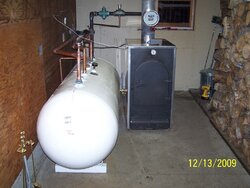I found a used 1000 gallon propane tank. It was removed from service because the data tag came off.
The guy that I am buying it from said his dad is a qualified welder that can add what ever ports I need before I pick it up. $50 dollars and hour plus fitting cost.
The tank has fittings of
1-1/2" with dip tube
2"
plus two 1-1/2"
He said they are close together in the middle.
What should I have him add for ports?
It will be pressure tested before I pick it up. What psi should I tell them to go to?
gg
The guy that I am buying it from said his dad is a qualified welder that can add what ever ports I need before I pick it up. $50 dollars and hour plus fitting cost.
The tank has fittings of
1-1/2" with dip tube
2"
plus two 1-1/2"
He said they are close together in the middle.
What should I have him add for ports?
It will be pressure tested before I pick it up. What psi should I tell them to go to?
gg


